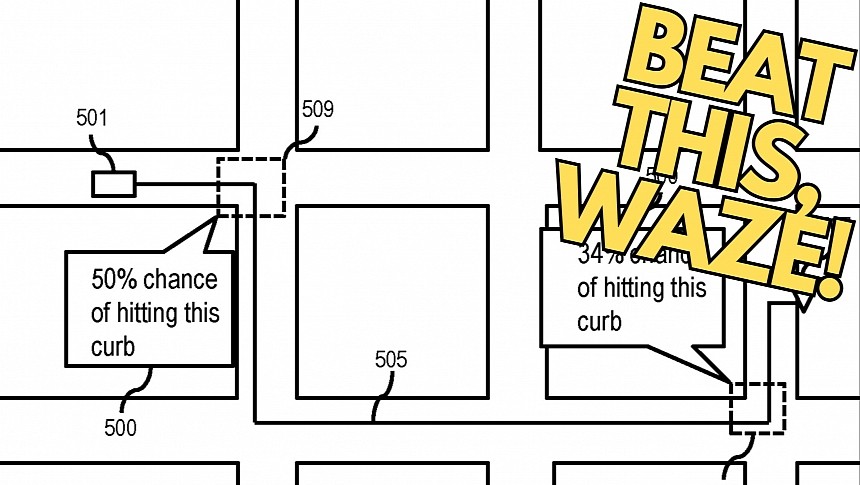You'd think that drivers should be able to see and avoid curbs, but depending on the road and the obstacles on the side, it might actually be really difficult to spot all of them.
HERE, the company best known for its navigation software, part of which competes against the likes of Google Maps, acknowledges that spotting the curbs is something really hard, especially when making a turn.
Nobody likes hitting a curb for obvious reasons, so HERE has come up with new technology that'll help find the dangerous spots and warn drivers about them. Best of all, it runs automatically, so you won't need to do anything to get the warnings.
HERE's technology is detailed in a recent patent, with the company explaining that curbs placed on street corners are typically the hardest to spot by drivers.
The system can monitor the road using onboard hardware, including sensors and cameras, to look for dangerous curbs. Once the system has enough data, it can estimate the chances of hitting a curb, eventually determining if the driver must receive a notification when approaching the corner.
HERE explains in the patent that the technology can run in the background with no user input. Several onboard systems can feed data into a server, which can then process various types of data, from image footage captured by cameras to the direction of the vehicle – such as when the driver spots the curb and suddenly steers to avoid it. Based on all these details, HERE's technology can determine if a dangerous curb is placed on a corner, flagging it on the map and generating alerts for drivers running the software.
The system also integrates a crowdsourcing component, so drivers can also mark dangerous locations. The feature can collect additional data using the onboard hardware to run additional analysis. Once a driver marks a dangerous curb, the system reinitiates the typical process, looking for data to determine the likelihood of a driver hitting the curb.
HERE explains that it can also analyze historical data and train a machine-learning model to predict when a driver could hit a curb. The system could, therefore, offer a personalized experience and generate warnings based on the estimated chances of hitting a curb per driver.
It's too early to tell if this technology will eventually make its way to users, as it's currently in the patent stage, and there's no guarantee it'll evolve past this phase. Companies sometimes patent new technologies just to protect their ideas, though in this case, a curb warning system would make sense for drivers worldwide. Theoretically, we can already have such notifications with Waze if users send hazard reports, but HERE's concept works automatically without any user input and based solely on vehicle hardware.
Nobody likes hitting a curb for obvious reasons, so HERE has come up with new technology that'll help find the dangerous spots and warn drivers about them. Best of all, it runs automatically, so you won't need to do anything to get the warnings.
HERE's technology is detailed in a recent patent, with the company explaining that curbs placed on street corners are typically the hardest to spot by drivers.
The system can monitor the road using onboard hardware, including sensors and cameras, to look for dangerous curbs. Once the system has enough data, it can estimate the chances of hitting a curb, eventually determining if the driver must receive a notification when approaching the corner.
HERE explains in the patent that the technology can run in the background with no user input. Several onboard systems can feed data into a server, which can then process various types of data, from image footage captured by cameras to the direction of the vehicle – such as when the driver spots the curb and suddenly steers to avoid it. Based on all these details, HERE's technology can determine if a dangerous curb is placed on a corner, flagging it on the map and generating alerts for drivers running the software.
The system also integrates a crowdsourcing component, so drivers can also mark dangerous locations. The feature can collect additional data using the onboard hardware to run additional analysis. Once a driver marks a dangerous curb, the system reinitiates the typical process, looking for data to determine the likelihood of a driver hitting the curb.
HERE explains that it can also analyze historical data and train a machine-learning model to predict when a driver could hit a curb. The system could, therefore, offer a personalized experience and generate warnings based on the estimated chances of hitting a curb per driver.
It's too early to tell if this technology will eventually make its way to users, as it's currently in the patent stage, and there's no guarantee it'll evolve past this phase. Companies sometimes patent new technologies just to protect their ideas, though in this case, a curb warning system would make sense for drivers worldwide. Theoretically, we can already have such notifications with Waze if users send hazard reports, but HERE's concept works automatically without any user input and based solely on vehicle hardware.

















